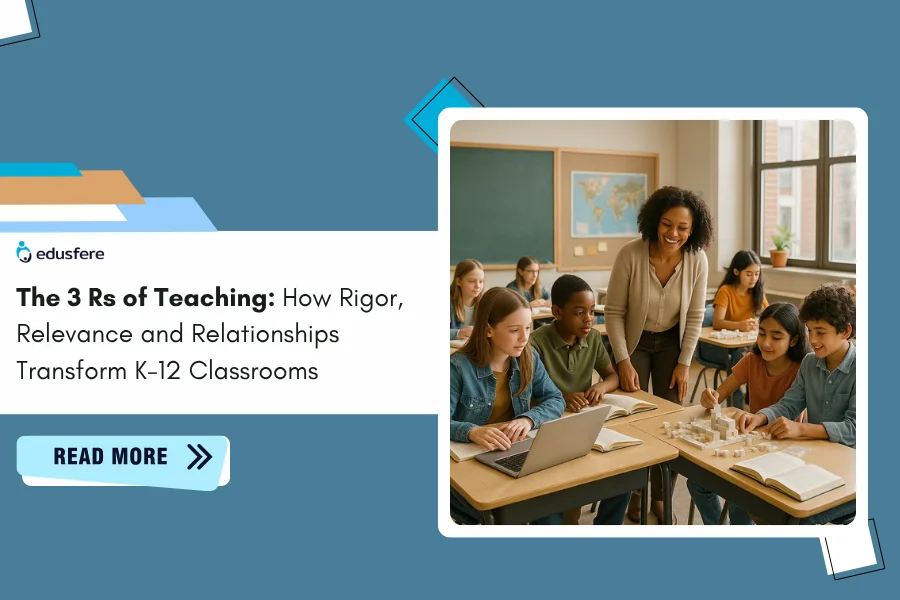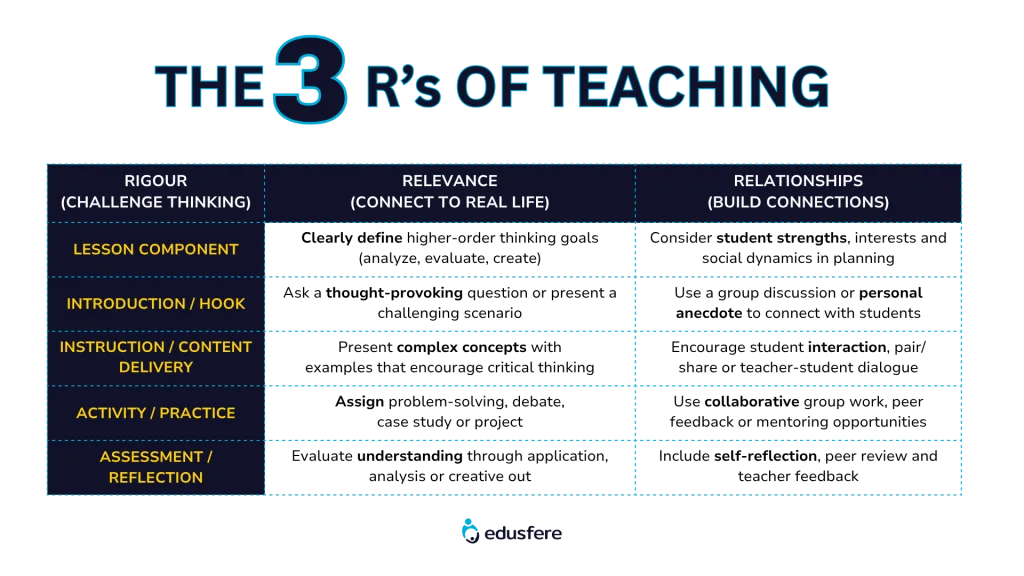Schedule a free demo to learn more
1st July 2025
The 3 Rs of Teaching: How Rigor, Relevance and Relationships Transform K-12 Classrooms

Many U.S. K-12 classrooms have centered learning around standardized testing, grade-level benchmarks and a strong emphasis on measurable outcomes. While this approach provided consistency and accountability, it often came at the cost of narrowing the curriculum, limiting creativity and placing less emphasis on skills like critical thinking, collaboration and problem-solving that students need.
Today, educators recognize that academic success requires not only foundational skills but also critical thinking, meaningful connections to real-world contexts and strong interpersonal relationships. And the Three Rs of Teaching, i.e. Rigor, Relevance and Relationships form the epicenter of the modern educational framework.
First introduced by educational leader Bill Daggett, the three Rs provide a practical, research-backed approach to creating classrooms where students are intellectually challenged, engaged and supported emotionally.
In today’s blog, we will explore each R in detail, explain how they intersect and provide classroom engagement strategies, teacher resources and transformational teaching strategies to help educators implement this framework successfully.
What are the Three R’s (3 Rs) of Teaching?
The term 3 R in teaching has evolved from its historical meaning of “reading, ‘riting, and ‘rithmetic” to represent three pillars that modern educators use to transform learning. The three Rs (Rigor, Relevance, and Relationships) are interconnected elements that guide effective teaching strategies, helping students achieve deep understanding while feeling supported in the learning process.
Rigor focuses on intellectual challenge and the development of higher-order thinking skills.
Relevance ensures that learning connects to students’ lives, interests and future goals.
Relationships provide the supportive foundation that enables students to engage fully and take risks in learning.
Research consistently shows that when these three pillars are balanced, students demonstrate higher engagement, better academic outcomes and increased motivation. In fact, Gallup’s 2023 Student Poll indicates that students who perceive their learning as both meaningful and challenging are significantly more likely to be engaged in school.
How teachers can implement Rigor, Relevance and Relationships in the Classroom
Rigor in Teaching Strategies: Elevating intellectual challenge
Rigor in teaching strategies is often misunderstood. It is not simply assigning more homework or increasing difficulty; it is about creating learning experiences that push students to think critically, problem-solve and apply knowledge creatively. Rigor transforms classrooms from spaces of passive absorption to environments of active, reflective learning.
Why Rigor matters in K-12 Classrooms
According to the OECD Education at a Glance 2024 report, students exposed to challenging curricula are more likely to develop cognitive skills that prepare them for success in higher education and the workforce.
Rigor also promotes resilience. When students face intellectually demanding tasks with appropriate support, they learn persistence, problem-solving and adaptive thinking, all of which are the skills essential for lifelong learning.
Classroom Engagement Strategies for Rigor
Practical strategies to embed rigor in your classroom include:
Project-Based Learning (PBL): Students tackle authentic, complex problems that require higher-order thinking and collaboration.
Inquiry-Based Learning: Encourage students to ask questions, investigate solutions and present findings.
Performance-based Assessments: Replace rote testing with authentic demonstrations of learning, such as presentations, prototypes or research projects.
Socratic Questioning: Challenge students to defend their reasoning, evaluate alternatives and reflect on assumptions.
These transformational teaching strategies foster deep engagement while maintaining high expectations for all students.
Relevance in Teaching Strategies: Connecting learning to life
Relevance in teaching strategies ensures that what students learn has meaning beyond the classroom. When students see a connection between their education and real-world applications, motivation, retention and engagement all improve.
Why does Relevance matter?
A Gallup 2023 study reports that students who perceive learning as relevant to their personal lives, career aspirations or community interests are more engaged and more likely to pursue academic challenges. Relevance increases intrinsic motivation, which research shows is a key predictor of academic success.
How to make learning Relevant
Educators can enhance relevance through:
Personal Connections: Link lessons to students’ identities, interests and experiences.
Contextual Relevance: Use current events, social issues or local community challenges as teaching material.
Future Relevance: Prepare students with transferable skills needed for higher education and careers, such as communication, collaboration and digital literacy.
Choice and Voice: Allow students to select topics, projects or formats that resonate with them.
By combining relevance with rigor, educators create learning experiences that are both challenging and meaningful, which in turn, is essential for transformative teaching strategies.
Relationships in Teaching Strategies: Building a supportive classroom
The third R, Relationships in teaching strategies, emphasizes the importance of social and emotional connections. Research by CASEL (Collaborative for Academic, Social and Emotional Learning) demonstrates that strong student-teacher relationships improve academic performance, attendance and engagement.
Why Relationships matter
Students who feel supported, known and respected are more willing to take risks, persevere through challenges and collaborate with peers. Relationships act as the foundation that allows rigor and relevance to be effective.
Classroom Engagement Strategies for Building Relationships
Building relationships based on trust in a classroom is often easier said than done. However, here are a few ways that can help you address this:
Warm Demander Approach: Teachers maintain high expectations while providing empathetic support.
Regular check-ins: Short, consistent one-on-one interactions help monitor academic and emotional well-being.
Collaborative Routines: Establish norms for peer interaction, group work and respectful discussion.
Recognition and encouragement: Celebrate progress and small achievements to build trust and motivation.
These strategies enhance student engagement and are critical for implementing transformational teaching strategies effectively.

How do the Three Rs Work Together?
The 3 R’s- Rigor, relevance and relationships are most powerful when integrated. Individually, each of them has a strategic value. And together, they create transformational learning environments wherein:
- Rigor without relevance may feel abstract or punitive.
- Relevance without rigor may lack depth or challenge.
- Rigor and relevance without relationships may feel unsupported or stressful.
Meanwhile, the sweet spot occurs when students are challenged, see purpose in their learning and feel emotionally supported. All of this constitutes the very essence of transformative teaching strategies.
Teacher Resources and Classroom Engagement Strategies for the Three Rs
Educators can leverage a variety of teacher resources and classroom engagement strategies to implement the three Rs effectively:
- Performance Task Rubrics: Assess critical thinking and application, not just recall.
- Project-based Learning Guides: Step-by-step frameworks for authentic, real-world projects.
- SEL Tools: Check-ins, reflection journals, and discussion norms to strengthen relationships.
- Engagement Trackers: Surveys, exit tickets and dashboards to monitor participation and engagement.
These transformational teaching strategies help educators create classrooms that are rigorous, relevant and relationship-rich.
Frequently Asked Questions (FAQs) about the 3 Rs of Teaching
Q1: What are the 3 Rs of teaching?
The 3 Rs refer to Rigor, Relevance, and Relationships, a framework that guides educators in creating classrooms that challenge students, connect learning to real life and build supportive relationships.
Q2: How can rigor improve classroom engagement?
Rigor promotes higher-order thinking, problem-solving and meaningful challenges. When students are intellectually stimulated, engagement and motivation increase.
Q3: How can relevance be incorporated into lessons?
Integrate students’ interests, real-world problems and future skills into lessons. Use project-based learning, current events or community connections to make learning meaningful.
Q4: Why are relationships important in transformative teaching strategies?
Positive relationships build trust, increase engagement and support resilience. They are essential for students to take risks and benefit from rigorous, relevant learning experiences.
Q5: What teacher resources support the three Rs?
Performance task rubrics, PBL guides, SEL tools, engagement trackers and structured discussion norms help teachers implement rigorous, relevant and relational learning effectively.
Transforming K-12 Classrooms with the Three Rs
The Three Rs of Teaching (Rigor, Relevance, and Relationships) are more than educational concepts; they are the foundation of transformative teaching strategies. By integrating high intellectual challenge, meaningful connections to real life and supportive relationships, educators can create classrooms where students are engaged, motivated and prepared for the future.
At Edusfere, we believe these principles are essential for shaping 21st-century learners. Our teacher resources, classroom engagement strategies and insights into transformational teaching empower educators to implement the three Rs effectively, ensuring every student thrives.
Schedule a demo to explore our AI-powered Curriculum Mapping software to transform your classroom into a space where learning is rigorous, meaningful and effective.